ATMC BUS203 Business Law and Ethics Assignment Consumer Law Analysis
VerifiedAdded on 2023/01/16
|8
|2333
|81
Homework Assignment
AI Summary
This assignment solution addresses a case study involving Australian Consumer Law (ACL). It analyzes three transactions to determine consumer status under s.3(1) of the ACL, examining whether purchases of a rice cooker, electric drill, and electric toothbrush qualify. The solution then explores i...
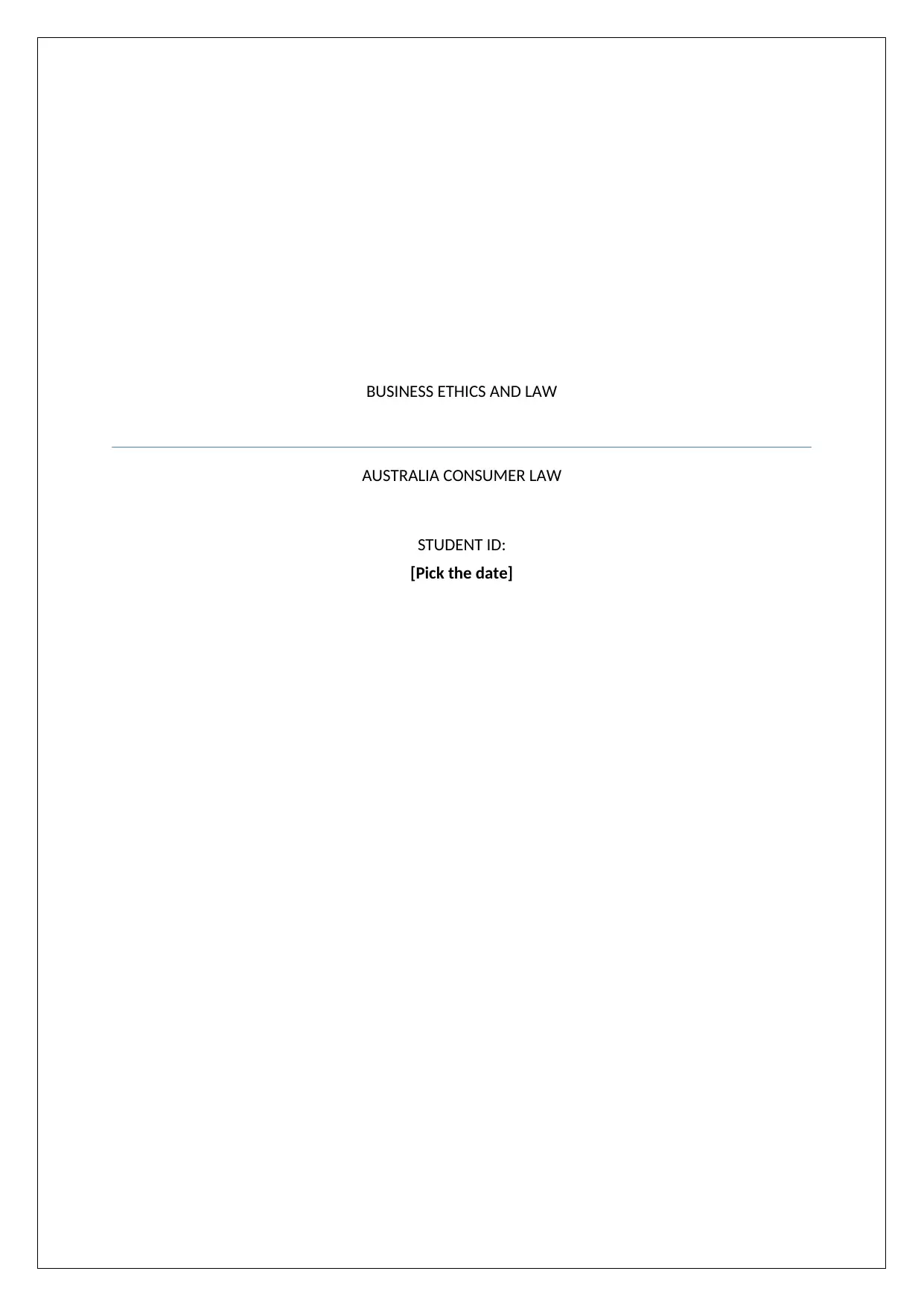
BUSINESS ETHICS AND LAW
AUSTRALIA CONSUMER LAW
STUDENT ID:
[Pick the date]
AUSTRALIA CONSUMER LAW
STUDENT ID:
[Pick the date]
Paraphrase This Document
Need a fresh take? Get an instant paraphrase of this document with our AI Paraphraser

Question 1
A key requirement for a transaction to be covered under the Australian Consumer Law (ACL)
is that the buyer must satisfy the definition of the consumer as has been indicated in s.3(1)
ACL. In accordance with this section, if the buyer satisfies the conditions listed below, then
he/she would be considered as buyer (Austlii, 2017).
The purchase price of the product for which the buyer has paid should not be greater
than $ 40,000, or
The product that has been purchased should be meant for personal usage instead of
commercial use
Three transactions have been entered into by Sangita and these need to be evaluated so as to
ascertain if Sangita for these transactions would be considered as consumer or not. The
significance of this lies in the fact that it would ascertain if the underlying transactions would
be covered by ACL or not.
Transaction A: Based on the given facts, it is known that Sangita has bought a rice cooker
which she intends to be used by Shindu (her aunt). Also, it is evident that the given rice
cooker purchased by Sangita would be sued for preparation of food for the family and hence
would not be deployed for any commercial purpose. Also, the price that Sangita has paid to
procure the rice cooker is $59.95. Hence, it may be appropriate to conclude that for the given
transaction, Sangita would be regarded as a consumer owing to good being cheaper than $
40,000 and meant for domestic use.
Transaction B: Based on the given facts, it is known that Sangita has bought an electric drill
which she intends to be used by Ramdas (her uncle). It is known that her uncle would use this
electric drill to conduct normal household repairs and this would not be used for any
commercial purpose. Also, the price that Sangita has paid to procure the electric drill is
$69.95. Hence, it may be appropriate to conclude that for the given transaction, Sangita
would be regarded as a consumer owing to good being cheaper than $ 40,000 and meant for
domestic use.
Transaction C: Based on the given facts, it is known that Sangita has bought an electric
toothbrush which she intends to be used by Pooja (her cousin). Also, it is known that the
A key requirement for a transaction to be covered under the Australian Consumer Law (ACL)
is that the buyer must satisfy the definition of the consumer as has been indicated in s.3(1)
ACL. In accordance with this section, if the buyer satisfies the conditions listed below, then
he/she would be considered as buyer (Austlii, 2017).
The purchase price of the product for which the buyer has paid should not be greater
than $ 40,000, or
The product that has been purchased should be meant for personal usage instead of
commercial use
Three transactions have been entered into by Sangita and these need to be evaluated so as to
ascertain if Sangita for these transactions would be considered as consumer or not. The
significance of this lies in the fact that it would ascertain if the underlying transactions would
be covered by ACL or not.
Transaction A: Based on the given facts, it is known that Sangita has bought a rice cooker
which she intends to be used by Shindu (her aunt). Also, it is evident that the given rice
cooker purchased by Sangita would be sued for preparation of food for the family and hence
would not be deployed for any commercial purpose. Also, the price that Sangita has paid to
procure the rice cooker is $59.95. Hence, it may be appropriate to conclude that for the given
transaction, Sangita would be regarded as a consumer owing to good being cheaper than $
40,000 and meant for domestic use.
Transaction B: Based on the given facts, it is known that Sangita has bought an electric drill
which she intends to be used by Ramdas (her uncle). It is known that her uncle would use this
electric drill to conduct normal household repairs and this would not be used for any
commercial purpose. Also, the price that Sangita has paid to procure the electric drill is
$69.95. Hence, it may be appropriate to conclude that for the given transaction, Sangita
would be regarded as a consumer owing to good being cheaper than $ 40,000 and meant for
domestic use.
Transaction C: Based on the given facts, it is known that Sangita has bought an electric
toothbrush which she intends to be used by Pooja (her cousin). Also, it is known that the
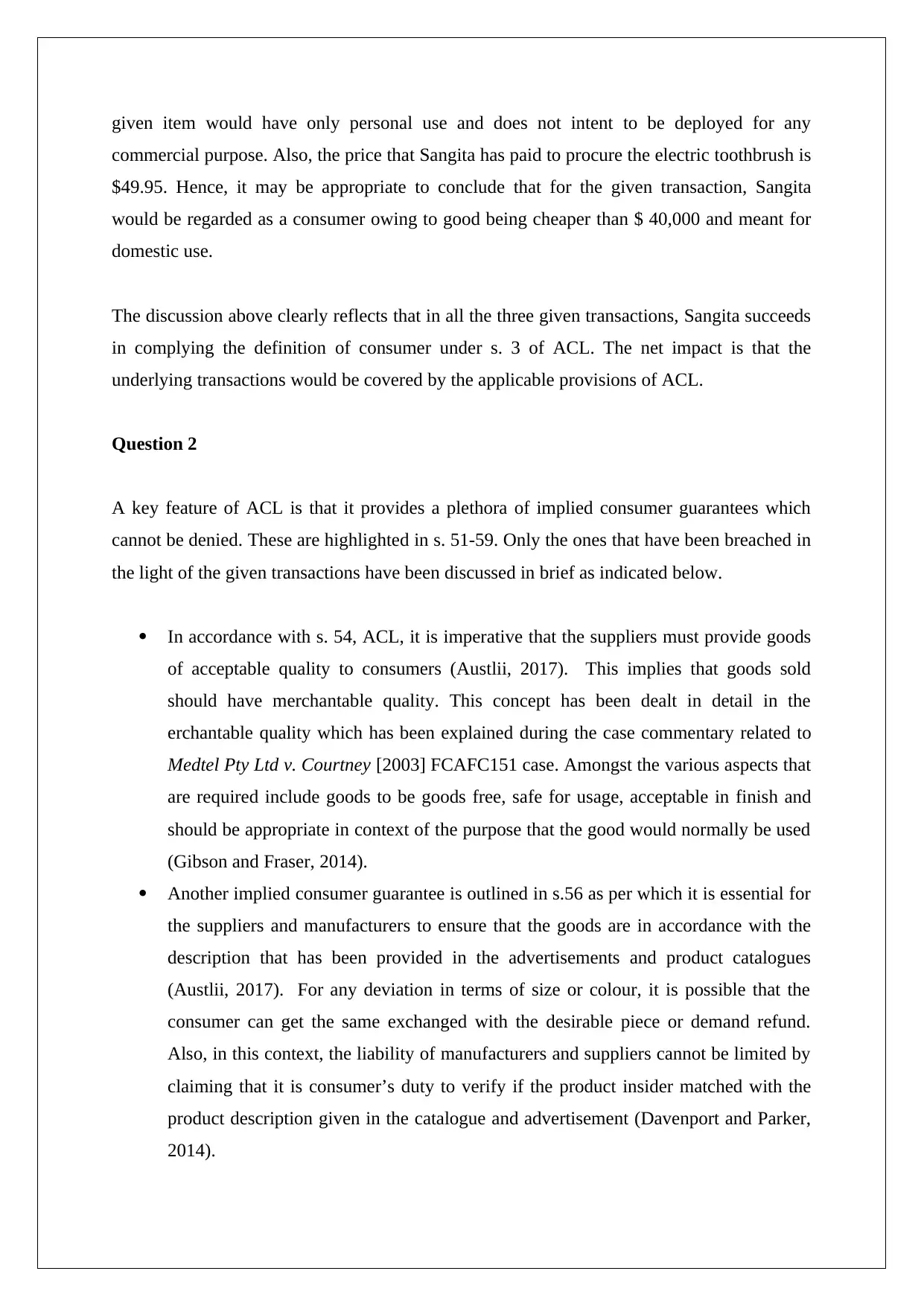
given item would have only personal use and does not intent to be deployed for any
commercial purpose. Also, the price that Sangita has paid to procure the electric toothbrush is
$49.95. Hence, it may be appropriate to conclude that for the given transaction, Sangita
would be regarded as a consumer owing to good being cheaper than $ 40,000 and meant for
domestic use.
The discussion above clearly reflects that in all the three given transactions, Sangita succeeds
in complying the definition of consumer under s. 3 of ACL. The net impact is that the
underlying transactions would be covered by the applicable provisions of ACL.
Question 2
A key feature of ACL is that it provides a plethora of implied consumer guarantees which
cannot be denied. These are highlighted in s. 51-59. Only the ones that have been breached in
the light of the given transactions have been discussed in brief as indicated below.
In accordance with s. 54, ACL, it is imperative that the suppliers must provide goods
of acceptable quality to consumers (Austlii, 2017). This implies that goods sold
should have merchantable quality. This concept has been dealt in detail in the
erchantable quality which has been explained during the case commentary related to
Medtel Pty Ltd v. Courtney [2003] FCAFC151 case. Amongst the various aspects that
are required include goods to be goods free, safe for usage, acceptable in finish and
should be appropriate in context of the purpose that the good would normally be used
(Gibson and Fraser, 2014).
Another implied consumer guarantee is outlined in s.56 as per which it is essential for
the suppliers and manufacturers to ensure that the goods are in accordance with the
description that has been provided in the advertisements and product catalogues
(Austlii, 2017). For any deviation in terms of size or colour, it is possible that the
consumer can get the same exchanged with the desirable piece or demand refund.
Also, in this context, the liability of manufacturers and suppliers cannot be limited by
claiming that it is consumer’s duty to verify if the product insider matched with the
product description given in the catalogue and advertisement (Davenport and Parker,
2014).
commercial purpose. Also, the price that Sangita has paid to procure the electric toothbrush is
$49.95. Hence, it may be appropriate to conclude that for the given transaction, Sangita
would be regarded as a consumer owing to good being cheaper than $ 40,000 and meant for
domestic use.
The discussion above clearly reflects that in all the three given transactions, Sangita succeeds
in complying the definition of consumer under s. 3 of ACL. The net impact is that the
underlying transactions would be covered by the applicable provisions of ACL.
Question 2
A key feature of ACL is that it provides a plethora of implied consumer guarantees which
cannot be denied. These are highlighted in s. 51-59. Only the ones that have been breached in
the light of the given transactions have been discussed in brief as indicated below.
In accordance with s. 54, ACL, it is imperative that the suppliers must provide goods
of acceptable quality to consumers (Austlii, 2017). This implies that goods sold
should have merchantable quality. This concept has been dealt in detail in the
erchantable quality which has been explained during the case commentary related to
Medtel Pty Ltd v. Courtney [2003] FCAFC151 case. Amongst the various aspects that
are required include goods to be goods free, safe for usage, acceptable in finish and
should be appropriate in context of the purpose that the good would normally be used
(Gibson and Fraser, 2014).
Another implied consumer guarantee is outlined in s.56 as per which it is essential for
the suppliers and manufacturers to ensure that the goods are in accordance with the
description that has been provided in the advertisements and product catalogues
(Austlii, 2017). For any deviation in terms of size or colour, it is possible that the
consumer can get the same exchanged with the desirable piece or demand refund.
Also, in this context, the liability of manufacturers and suppliers cannot be limited by
claiming that it is consumer’s duty to verify if the product insider matched with the
product description given in the catalogue and advertisement (Davenport and Parker,
2014).
⊘ This is a preview!⊘
Do you want full access?
Subscribe today to unlock all pages.

Trusted by 1+ million students worldwide
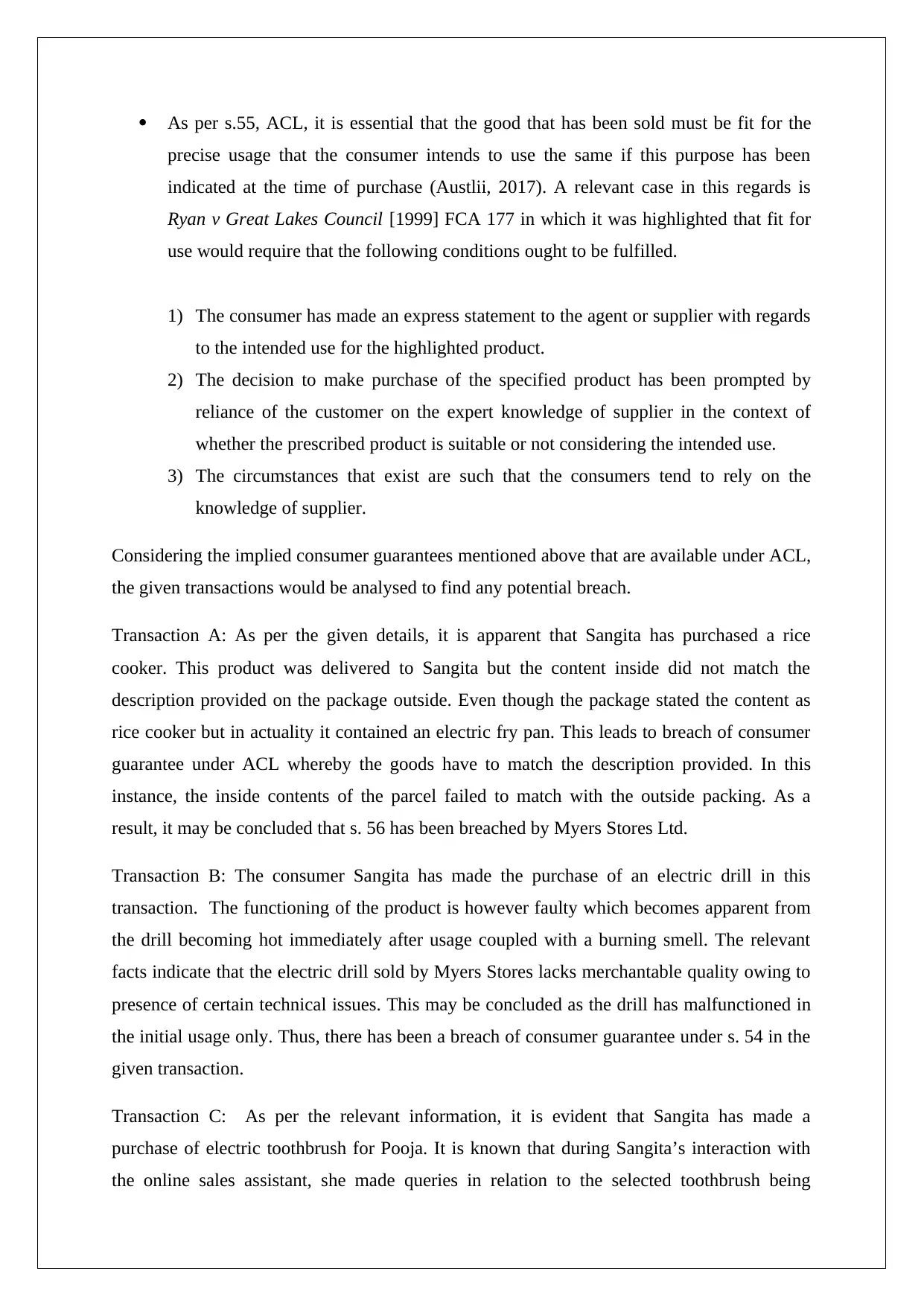
As per s.55, ACL, it is essential that the good that has been sold must be fit for the
precise usage that the consumer intends to use the same if this purpose has been
indicated at the time of purchase (Austlii, 2017). A relevant case in this regards is
Ryan v Great Lakes Council [1999] FCA 177 in which it was highlighted that fit for
use would require that the following conditions ought to be fulfilled.
1) The consumer has made an express statement to the agent or supplier with regards
to the intended use for the highlighted product.
2) The decision to make purchase of the specified product has been prompted by
reliance of the customer on the expert knowledge of supplier in the context of
whether the prescribed product is suitable or not considering the intended use.
3) The circumstances that exist are such that the consumers tend to rely on the
knowledge of supplier.
Considering the implied consumer guarantees mentioned above that are available under ACL,
the given transactions would be analysed to find any potential breach.
Transaction A: As per the given details, it is apparent that Sangita has purchased a rice
cooker. This product was delivered to Sangita but the content inside did not match the
description provided on the package outside. Even though the package stated the content as
rice cooker but in actuality it contained an electric fry pan. This leads to breach of consumer
guarantee under ACL whereby the goods have to match the description provided. In this
instance, the inside contents of the parcel failed to match with the outside packing. As a
result, it may be concluded that s. 56 has been breached by Myers Stores Ltd.
Transaction B: The consumer Sangita has made the purchase of an electric drill in this
transaction. The functioning of the product is however faulty which becomes apparent from
the drill becoming hot immediately after usage coupled with a burning smell. The relevant
facts indicate that the electric drill sold by Myers Stores lacks merchantable quality owing to
presence of certain technical issues. This may be concluded as the drill has malfunctioned in
the initial usage only. Thus, there has been a breach of consumer guarantee under s. 54 in the
given transaction.
Transaction C: As per the relevant information, it is evident that Sangita has made a
purchase of electric toothbrush for Pooja. It is known that during Sangita’s interaction with
the online sales assistant, she made queries in relation to the selected toothbrush being
precise usage that the consumer intends to use the same if this purpose has been
indicated at the time of purchase (Austlii, 2017). A relevant case in this regards is
Ryan v Great Lakes Council [1999] FCA 177 in which it was highlighted that fit for
use would require that the following conditions ought to be fulfilled.
1) The consumer has made an express statement to the agent or supplier with regards
to the intended use for the highlighted product.
2) The decision to make purchase of the specified product has been prompted by
reliance of the customer on the expert knowledge of supplier in the context of
whether the prescribed product is suitable or not considering the intended use.
3) The circumstances that exist are such that the consumers tend to rely on the
knowledge of supplier.
Considering the implied consumer guarantees mentioned above that are available under ACL,
the given transactions would be analysed to find any potential breach.
Transaction A: As per the given details, it is apparent that Sangita has purchased a rice
cooker. This product was delivered to Sangita but the content inside did not match the
description provided on the package outside. Even though the package stated the content as
rice cooker but in actuality it contained an electric fry pan. This leads to breach of consumer
guarantee under ACL whereby the goods have to match the description provided. In this
instance, the inside contents of the parcel failed to match with the outside packing. As a
result, it may be concluded that s. 56 has been breached by Myers Stores Ltd.
Transaction B: The consumer Sangita has made the purchase of an electric drill in this
transaction. The functioning of the product is however faulty which becomes apparent from
the drill becoming hot immediately after usage coupled with a burning smell. The relevant
facts indicate that the electric drill sold by Myers Stores lacks merchantable quality owing to
presence of certain technical issues. This may be concluded as the drill has malfunctioned in
the initial usage only. Thus, there has been a breach of consumer guarantee under s. 54 in the
given transaction.
Transaction C: As per the relevant information, it is evident that Sangita has made a
purchase of electric toothbrush for Pooja. It is known that during Sangita’s interaction with
the online sales assistant, she made queries in relation to the selected toothbrush being
Paraphrase This Document
Need a fresh take? Get an instant paraphrase of this document with our AI Paraphraser
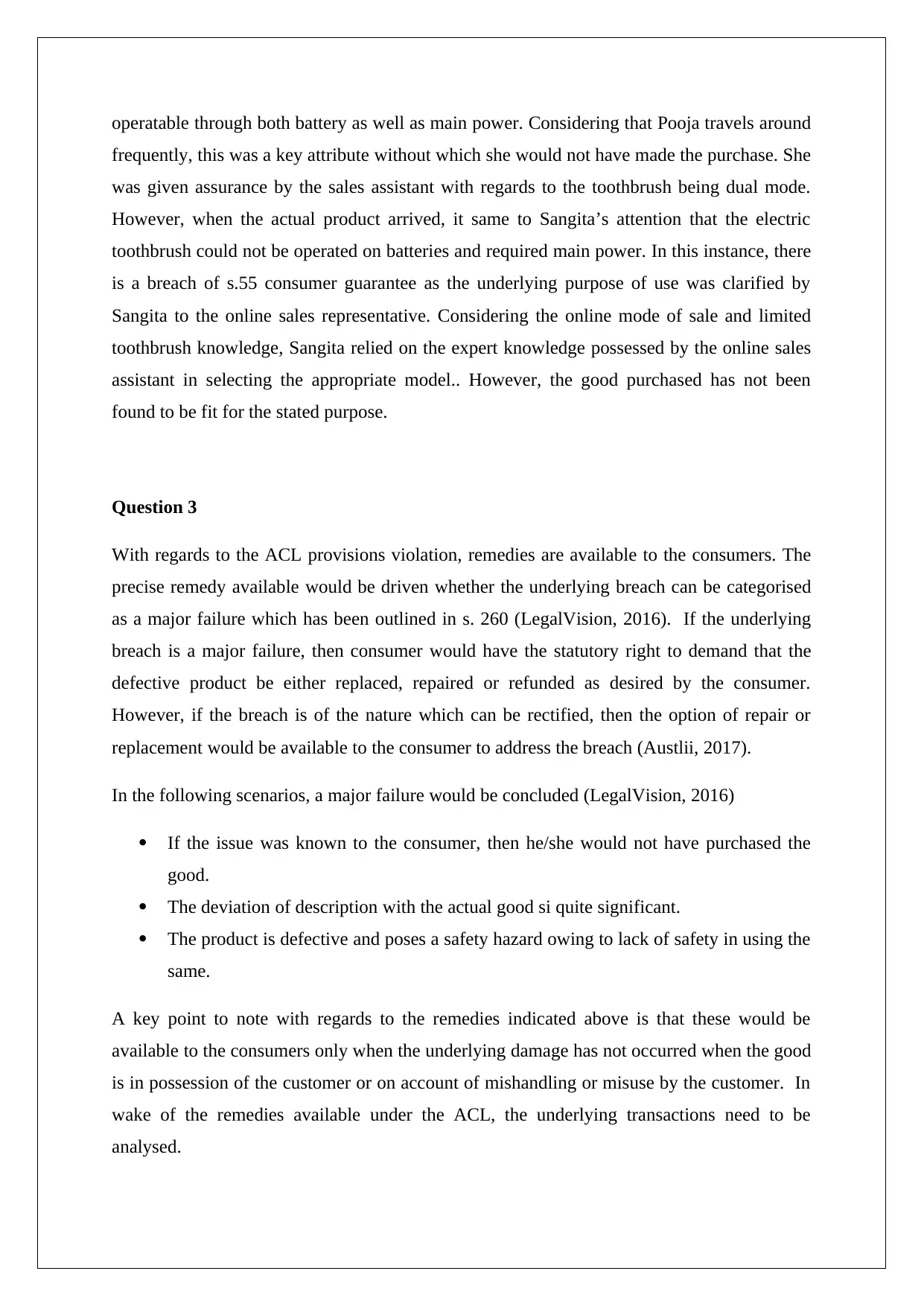
operatable through both battery as well as main power. Considering that Pooja travels around
frequently, this was a key attribute without which she would not have made the purchase. She
was given assurance by the sales assistant with regards to the toothbrush being dual mode.
However, when the actual product arrived, it same to Sangita’s attention that the electric
toothbrush could not be operated on batteries and required main power. In this instance, there
is a breach of s.55 consumer guarantee as the underlying purpose of use was clarified by
Sangita to the online sales representative. Considering the online mode of sale and limited
toothbrush knowledge, Sangita relied on the expert knowledge possessed by the online sales
assistant in selecting the appropriate model.. However, the good purchased has not been
found to be fit for the stated purpose.
Question 3
With regards to the ACL provisions violation, remedies are available to the consumers. The
precise remedy available would be driven whether the underlying breach can be categorised
as a major failure which has been outlined in s. 260 (LegalVision, 2016). If the underlying
breach is a major failure, then consumer would have the statutory right to demand that the
defective product be either replaced, repaired or refunded as desired by the consumer.
However, if the breach is of the nature which can be rectified, then the option of repair or
replacement would be available to the consumer to address the breach (Austlii, 2017).
In the following scenarios, a major failure would be concluded (LegalVision, 2016)
If the issue was known to the consumer, then he/she would not have purchased the
good.
The deviation of description with the actual good si quite significant.
The product is defective and poses a safety hazard owing to lack of safety in using the
same.
A key point to note with regards to the remedies indicated above is that these would be
available to the consumers only when the underlying damage has not occurred when the good
is in possession of the customer or on account of mishandling or misuse by the customer. In
wake of the remedies available under the ACL, the underlying transactions need to be
analysed.
frequently, this was a key attribute without which she would not have made the purchase. She
was given assurance by the sales assistant with regards to the toothbrush being dual mode.
However, when the actual product arrived, it same to Sangita’s attention that the electric
toothbrush could not be operated on batteries and required main power. In this instance, there
is a breach of s.55 consumer guarantee as the underlying purpose of use was clarified by
Sangita to the online sales representative. Considering the online mode of sale and limited
toothbrush knowledge, Sangita relied on the expert knowledge possessed by the online sales
assistant in selecting the appropriate model.. However, the good purchased has not been
found to be fit for the stated purpose.
Question 3
With regards to the ACL provisions violation, remedies are available to the consumers. The
precise remedy available would be driven whether the underlying breach can be categorised
as a major failure which has been outlined in s. 260 (LegalVision, 2016). If the underlying
breach is a major failure, then consumer would have the statutory right to demand that the
defective product be either replaced, repaired or refunded as desired by the consumer.
However, if the breach is of the nature which can be rectified, then the option of repair or
replacement would be available to the consumer to address the breach (Austlii, 2017).
In the following scenarios, a major failure would be concluded (LegalVision, 2016)
If the issue was known to the consumer, then he/she would not have purchased the
good.
The deviation of description with the actual good si quite significant.
The product is defective and poses a safety hazard owing to lack of safety in using the
same.
A key point to note with regards to the remedies indicated above is that these would be
available to the consumers only when the underlying damage has not occurred when the good
is in possession of the customer or on account of mishandling or misuse by the customer. In
wake of the remedies available under the ACL, the underlying transactions need to be
analysed.
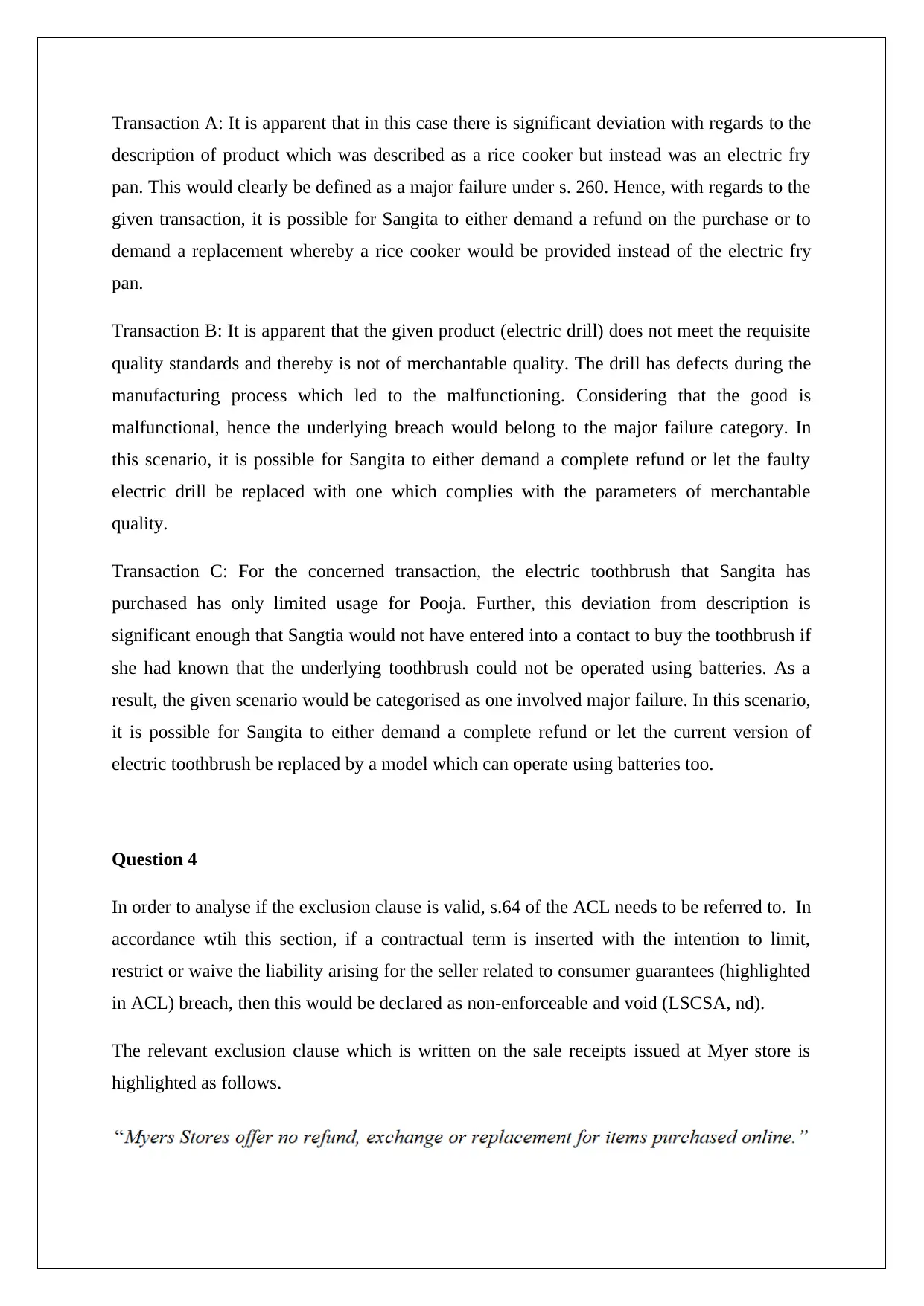
Transaction A: It is apparent that in this case there is significant deviation with regards to the
description of product which was described as a rice cooker but instead was an electric fry
pan. This would clearly be defined as a major failure under s. 260. Hence, with regards to the
given transaction, it is possible for Sangita to either demand a refund on the purchase or to
demand a replacement whereby a rice cooker would be provided instead of the electric fry
pan.
Transaction B: It is apparent that the given product (electric drill) does not meet the requisite
quality standards and thereby is not of merchantable quality. The drill has defects during the
manufacturing process which led to the malfunctioning. Considering that the good is
malfunctional, hence the underlying breach would belong to the major failure category. In
this scenario, it is possible for Sangita to either demand a complete refund or let the faulty
electric drill be replaced with one which complies with the parameters of merchantable
quality.
Transaction C: For the concerned transaction, the electric toothbrush that Sangita has
purchased has only limited usage for Pooja. Further, this deviation from description is
significant enough that Sangtia would not have entered into a contact to buy the toothbrush if
she had known that the underlying toothbrush could not be operated using batteries. As a
result, the given scenario would be categorised as one involved major failure. In this scenario,
it is possible for Sangita to either demand a complete refund or let the current version of
electric toothbrush be replaced by a model which can operate using batteries too.
Question 4
In order to analyse if the exclusion clause is valid, s.64 of the ACL needs to be referred to. In
accordance wtih this section, if a contractual term is inserted with the intention to limit,
restrict or waive the liability arising for the seller related to consumer guarantees (highlighted
in ACL) breach, then this would be declared as non-enforceable and void (LSCSA, nd).
The relevant exclusion clause which is written on the sale receipts issued at Myer store is
highlighted as follows.
description of product which was described as a rice cooker but instead was an electric fry
pan. This would clearly be defined as a major failure under s. 260. Hence, with regards to the
given transaction, it is possible for Sangita to either demand a refund on the purchase or to
demand a replacement whereby a rice cooker would be provided instead of the electric fry
pan.
Transaction B: It is apparent that the given product (electric drill) does not meet the requisite
quality standards and thereby is not of merchantable quality. The drill has defects during the
manufacturing process which led to the malfunctioning. Considering that the good is
malfunctional, hence the underlying breach would belong to the major failure category. In
this scenario, it is possible for Sangita to either demand a complete refund or let the faulty
electric drill be replaced with one which complies with the parameters of merchantable
quality.
Transaction C: For the concerned transaction, the electric toothbrush that Sangita has
purchased has only limited usage for Pooja. Further, this deviation from description is
significant enough that Sangtia would not have entered into a contact to buy the toothbrush if
she had known that the underlying toothbrush could not be operated using batteries. As a
result, the given scenario would be categorised as one involved major failure. In this scenario,
it is possible for Sangita to either demand a complete refund or let the current version of
electric toothbrush be replaced by a model which can operate using batteries too.
Question 4
In order to analyse if the exclusion clause is valid, s.64 of the ACL needs to be referred to. In
accordance wtih this section, if a contractual term is inserted with the intention to limit,
restrict or waive the liability arising for the seller related to consumer guarantees (highlighted
in ACL) breach, then this would be declared as non-enforceable and void (LSCSA, nd).
The relevant exclusion clause which is written on the sale receipts issued at Myer store is
highlighted as follows.
⊘ This is a preview!⊘
Do you want full access?
Subscribe today to unlock all pages.

Trusted by 1+ million students worldwide
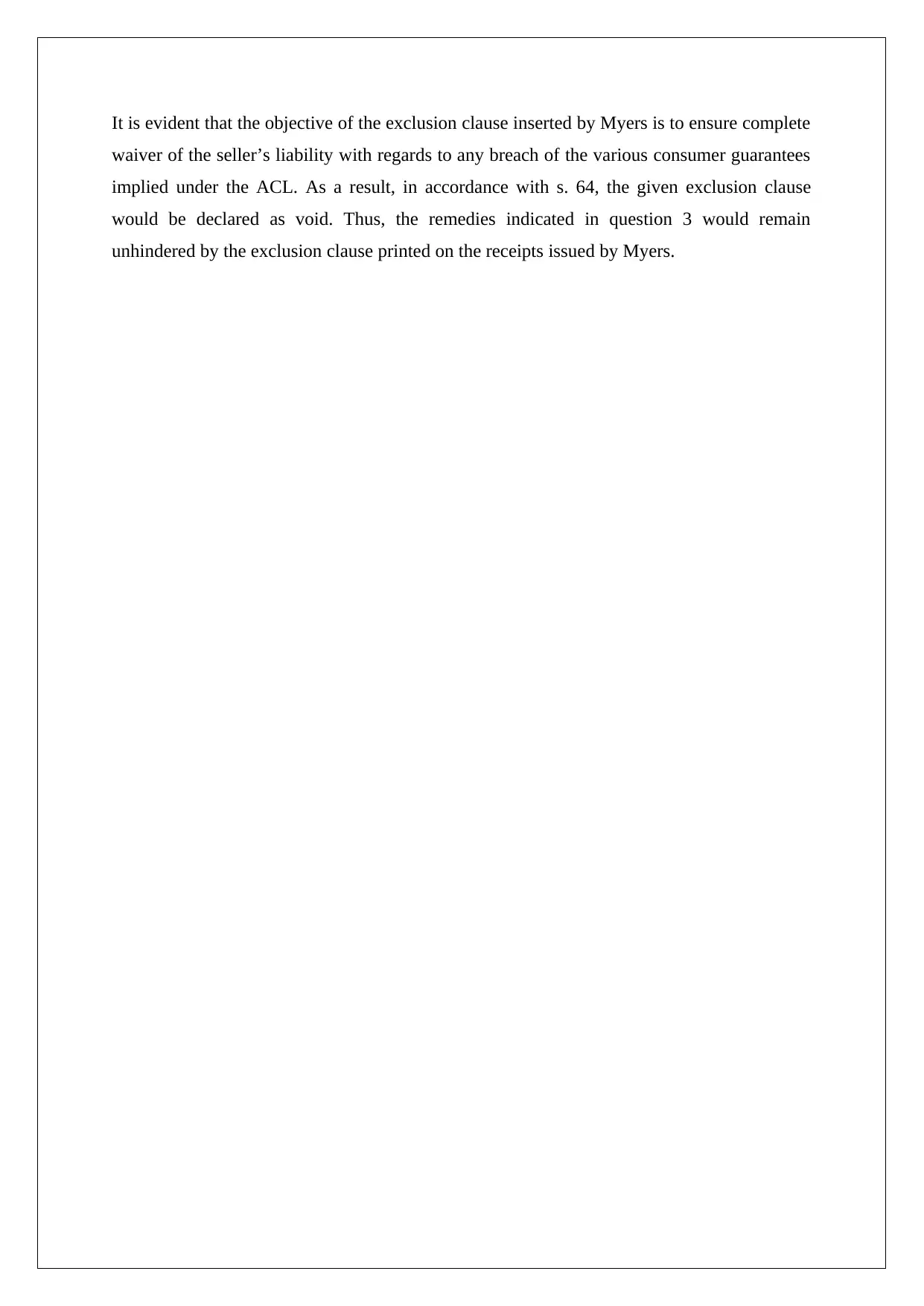
It is evident that the objective of the exclusion clause inserted by Myers is to ensure complete
waiver of the seller’s liability with regards to any breach of the various consumer guarantees
implied under the ACL. As a result, in accordance with s. 64, the given exclusion clause
would be declared as void. Thus, the remedies indicated in question 3 would remain
unhindered by the exclusion clause printed on the receipts issued by Myers.
waiver of the seller’s liability with regards to any breach of the various consumer guarantees
implied under the ACL. As a result, in accordance with s. 64, the given exclusion clause
would be declared as void. Thus, the remedies indicated in question 3 would remain
unhindered by the exclusion clause printed on the receipts issued by Myers.
Paraphrase This Document
Need a fresh take? Get an instant paraphrase of this document with our AI Paraphraser
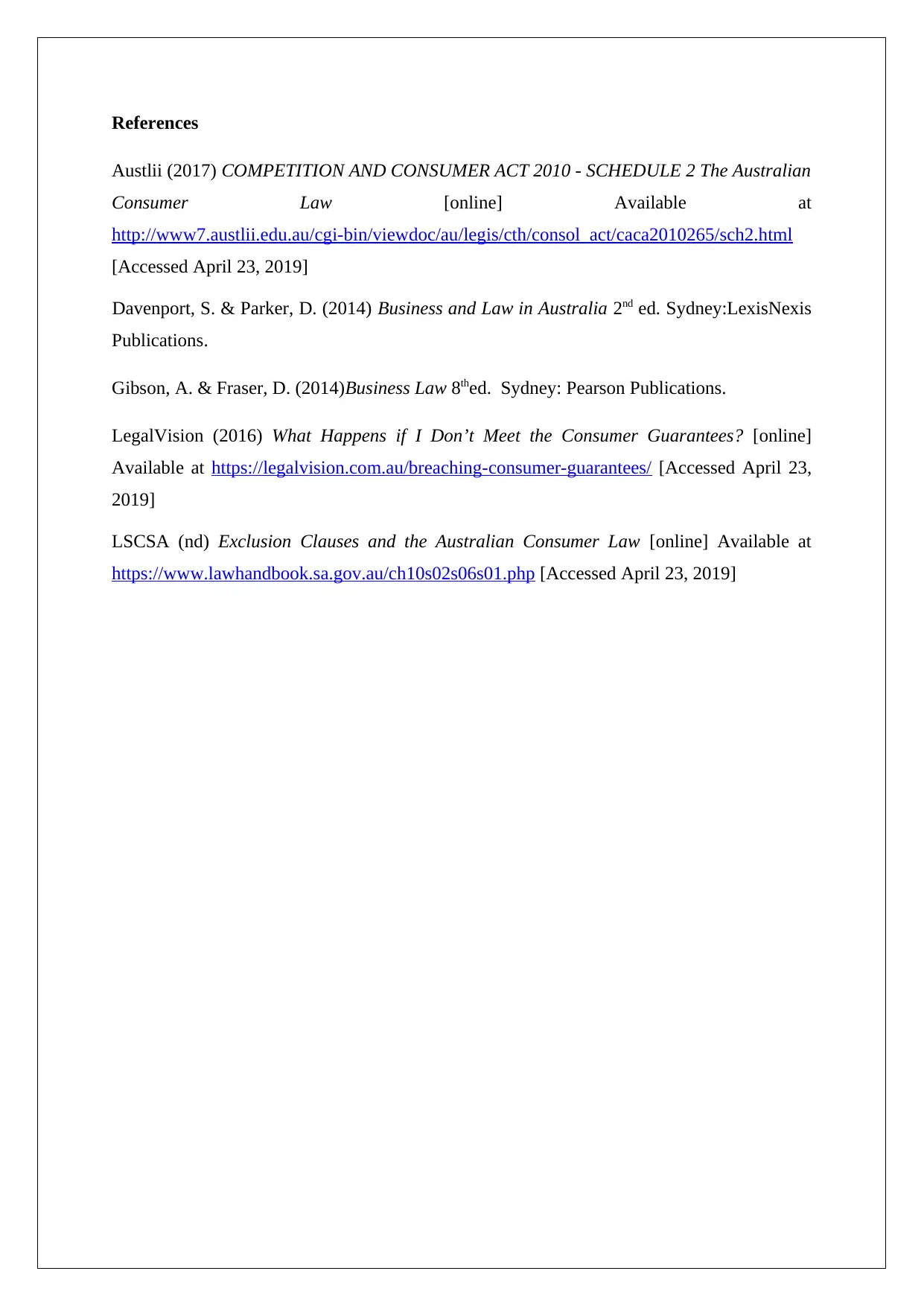
References
Austlii (2017) COMPETITION AND CONSUMER ACT 2010 - SCHEDULE 2 The Australian
Consumer Law [online] Available at
http://www7.austlii.edu.au/cgi-bin/viewdoc/au/legis/cth/consol_act/caca2010265/sch2.html
[Accessed April 23, 2019]
Davenport, S. & Parker, D. (2014) Business and Law in Australia 2nd ed. Sydney:LexisNexis
Publications.
Gibson, A. & Fraser, D. (2014)Business Law 8thed. Sydney: Pearson Publications.
LegalVision (2016) What Happens if I Don’t Meet the Consumer Guarantees? [online]
Available at https://legalvision.com.au/breaching-consumer-guarantees/ [Accessed April 23,
2019]
LSCSA (nd) Exclusion Clauses and the Australian Consumer Law [online] Available at
https://www.lawhandbook.sa.gov.au/ch10s02s06s01.php [Accessed April 23, 2019]
Austlii (2017) COMPETITION AND CONSUMER ACT 2010 - SCHEDULE 2 The Australian
Consumer Law [online] Available at
http://www7.austlii.edu.au/cgi-bin/viewdoc/au/legis/cth/consol_act/caca2010265/sch2.html
[Accessed April 23, 2019]
Davenport, S. & Parker, D. (2014) Business and Law in Australia 2nd ed. Sydney:LexisNexis
Publications.
Gibson, A. & Fraser, D. (2014)Business Law 8thed. Sydney: Pearson Publications.
LegalVision (2016) What Happens if I Don’t Meet the Consumer Guarantees? [online]
Available at https://legalvision.com.au/breaching-consumer-guarantees/ [Accessed April 23,
2019]
LSCSA (nd) Exclusion Clauses and the Australian Consumer Law [online] Available at
https://www.lawhandbook.sa.gov.au/ch10s02s06s01.php [Accessed April 23, 2019]
1 out of 8
Related Documents
Your All-in-One AI-Powered Toolkit for Academic Success.
+13062052269
info@desklib.com
Available 24*7 on WhatsApp / Email
![[object Object]](/_next/static/media/star-bottom.7253800d.svg)
Unlock your academic potential
© 2024 | Zucol Services PVT LTD | All rights reserved.





